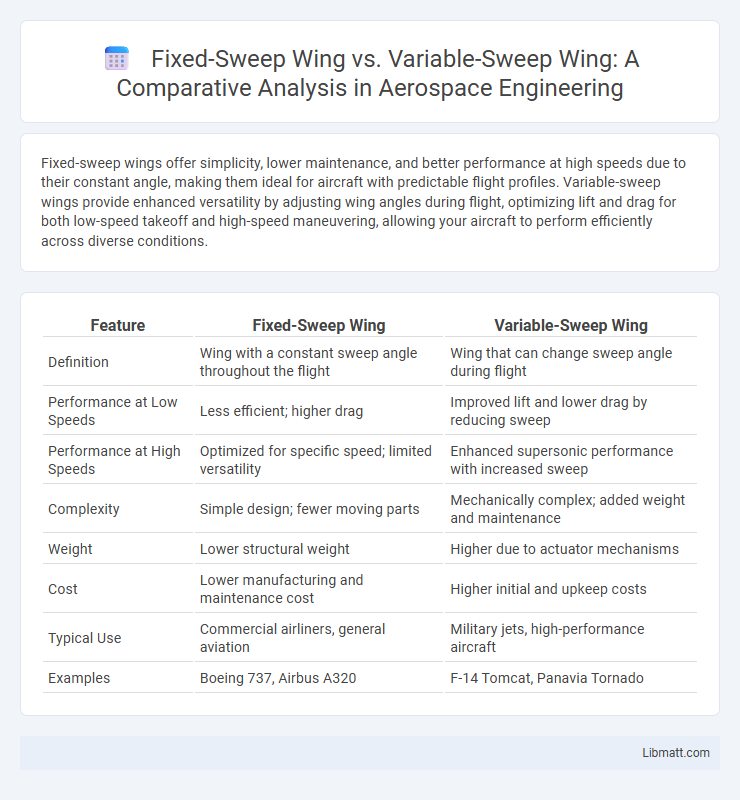Fixed-sweep wings offer simplicity, lower maintenance, and better performance at high speeds due to their constant angle, making them ideal for aircraft with predictable flight profiles. Variable-sweep wings provide enhanced versatility by adjusting wing angles during flight, optimizing lift and drag for both low-speed takeoff and high-speed maneuvering, allowing your aircraft to perform efficiently across diverse conditions.
Table of Comparison
| Feature | Fixed-Sweep Wing | Variable-Sweep Wing |
|---|---|---|
| Definition | Wing with a constant sweep angle throughout the flight | Wing that can change sweep angle during flight |
| Performance at Low Speeds | Less efficient; higher drag | Improved lift and lower drag by reducing sweep |
| Performance at High Speeds | Optimized for specific speed; limited versatility | Enhanced supersonic performance with increased sweep |
| Complexity | Simple design; fewer moving parts | Mechanically complex; added weight and maintenance |
| Weight | Lower structural weight | Higher due to actuator mechanisms |
| Cost | Lower manufacturing and maintenance cost | Higher initial and upkeep costs |
| Typical Use | Commercial airliners, general aviation | Military jets, high-performance aircraft |
| Examples | Boeing 737, Airbus A320 | F-14 Tomcat, Panavia Tornado |
Introduction to Aircraft Wing Designs
Fixed-sweep wings feature a constant angle along the wing span, providing structural simplicity and efficiency at subsonic speeds, commonly used in commercial airliners and light aircraft. Variable-sweep wings, capable of adjusting their sweep angle in flight, optimize aerodynamic performance across a wide speed range, enhancing both low-speed handling and supersonic cruise capabilities, as seen in military aircraft like the F-14 Tomcat. The choice between fixed-sweep and variable-sweep wings impacts fuel efficiency, maneuverability, and mission adaptability, making it critical in aircraft design decisions.
What is a Fixed-Sweep Wing?
A fixed-sweep wing features a constant angle relative to the fuselage, designed for optimal performance at specific speeds and flight conditions, commonly found on many commercial and fighter aircraft. This wing type offers structural simplicity, lower maintenance costs, and reliable aerodynamic stability, making it ideal for consistent cruising speeds. Understanding the advantages of a fixed-sweep wing helps you appreciate its efficiency in aircraft designed for straightforward and predictable flight profiles.
What is a Variable-Sweep Wing?
A variable-sweep wing, also known as a swing wing, is an aircraft wing design that allows the wings to change their sweep angle during flight to optimize performance at different speeds. This design enables better low-speed handling and takeoff performance with wings extended, while providing reduced drag and enhanced stability at supersonic speeds when wings are swept back. Your understanding of variable-sweep wings highlights their versatility in adapting aircraft aerodynamics for both efficient cruising and agile maneuvering.
Aerodynamic Advantages of Fixed-Sweep Wings
Fixed-sweep wings provide consistent aerodynamic performance optimized for specific flight regimes, offering lower structural complexity and reduced weight compared to variable-sweep designs. Their fixed geometry allows for improved lift-to-drag ratios at moderate speeds, enhancing fuel efficiency and stability during cruise. This simplicity reduces maintenance needs and manufacturing costs, making fixed-sweep wings ideal for aircraft operating primarily within limited speed ranges.
Aerodynamic Benefits of Variable-Sweep Wings
Variable-sweep wings offer significant aerodynamic advantages by allowing the adjustment of wing sweep angle during flight, optimizing lift and drag characteristics for different speeds. At low speeds, wings can be extended to increase lift and improve takeoff and landing performance, while at high speeds, wings sweep back to reduce drag and enhance stability. Your aircraft benefits from enhanced fuel efficiency and maneuverability across a broader range of flight conditions with this adaptable wing design.
Structural Complexity and Maintenance
Fixed-sweep wings feature a simpler structural design, leading to reduced maintenance requirements and lower production costs. Variable-sweep wings incorporate intricate pivot mechanisms and actuators that increase structural complexity, necessitating frequent inspections and specialized upkeep. The advanced engineering of variable-sweep wings results in higher maintenance demands compared to fixed-sweep configurations.
Performance at Different Flight Regimes
Fixed-sweep wings offer optimal performance at specific flight regimes, providing efficient lift and stability during subsonic speeds but facing increased drag at supersonic velocities. Variable-sweep wings enhance versatility by adjusting wing angles to optimize aerodynamics across a wide range of speeds, improving fuel efficiency and maneuverability from low-speed takeoff to high-speed flight. Your aircraft benefits from tailored wing configurations that balance the trade-offs between stability, lift, and drag throughout diverse flight conditions.
Applications in Military and Civil Aviation
Fixed-sweep wings offer simplicity and structural strength, making them ideal for commercial airliners and many military trainers due to efficient cruise performance and lower maintenance. Variable-sweep wings excel in military applications requiring versatility, enabling aircraft like the F-14 Tomcat to optimize aerodynamics for both high-speed supersonic flight and slower, maneuverable operations. Your choice between these wing designs depends on mission profiles, with fixed-sweep favored for reliability and efficiency in civil aviation, while variable-sweep suits combat jets demanding multi-role flexibility.
Cost, Weight, and Engineering Considerations
Fixed-sweep wings offer lower manufacturing and maintenance costs due to simpler structures and fewer moving parts, resulting in reduced aircraft weight and enhanced fuel efficiency. Variable-sweep wings require complex pivot mechanisms and hydraulic systems, increasing both engineering challenges and overall aircraft weight, impacting performance and upkeep expenses. Your choice depends on balancing these factors against mission requirements, with fixed-sweep wings favoring cost-effectiveness and variable-sweep wings providing superior aerodynamic versatility.
Future Trends: Fixed vs. Variable-Sweep Wing Technologies
Future trends indicate a growing preference for fixed-sweep wings due to advancements in composite materials and aerodynamic designs that enhance fuel efficiency and reduce maintenance costs. Variable-sweep wings, while offering superior performance across diverse flight conditions, face challenges in mechanical complexity and weight penalties limiting their use in next-generation aircraft. Emerging technologies in adaptive wing structures and morphing materials may bridge the gap, providing the benefits of variable geometry without traditional drawbacks.
Fixed-sweep wing vs Variable-sweep wing Infographic

 libmatt.com
libmatt.com